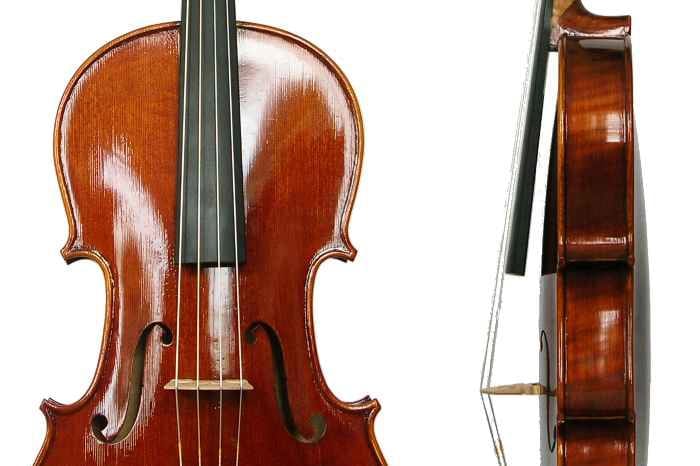Imagine you have a pizza.

On the bottom, you’ve got the crust. Whether crispy or stuffed, bland or decadent, the crust serves as a base to the rest of the ingredients. On top, you have the fun stuff — sausage! mozzarella! mushrooms! pineapple! Toppings get all the glory, don’t they?
In the middle, you’ve got the sauce. Oh, humble, hidden sauce. Rarely the star of the pizza, the sauce is that crucial, connective ingredient that we sorely miss when it’s gone.
• Crust (sturdy base) = cellos and basses
• Toppings (fancy parts, visible, glory) = violins
• Sauce (humble, middle, connective) = violas

The modern viola is a member of the violin family that can be crudely described as a cross between a violin and cello. Though simplistic, that description isn’t entirely wrong. After all, the viola looks like an oversized violin, is played “violin-style” under the chin, but is pitched a fifth lower than the violin. In other words, it shares the same string tunings as the cello (C-G-D-A as opposed to the violin’s G-D-A-E) but an octave higher.
Sonically, the viola dominates the mid-range. It is deeper than the violin, mellower, arguably more somber and distant. Even though the violin and viola technically share most of the same notes, the bigger body and thicker strings of the viola imbue it with a darker character. Composers can use this to their advantage; the viola adds connective “sauce” to disjointed orchestral moments (i.e. lots of bass, lots of treble, but nothing in the middle), boosts rhythmic variety, and portrays sensual, veiled, yearning moods, and more.
Unfortunately, much like with the other “underdog instruments” we’ve written about [looking at you bass clarinet], violas don’t get to shine very often. If you’ve never been able to tell the difference between a violin and a viola, you’re not alone. No need to feel embarrassed. But now, we’re about to change that. Here are five standout moments for the viola in orchestral literature for us to enjoy.
Háry János Suite, Mvt. III “Song” by Zoltán Kodály
Hungarian composer Kodály goes for the gold with a viola solo right at the top of the third movement, a love duet amidst the greater tale of veteran Háry János’s fantastical adventures.
Roman Carnival Overture by Hector Berlioz
Here we have not just a viola solo (only one person playing) but a viola soli, which means the whole viola section plays together. In this section, the violas jump in with a unison melody at the tail end of the English horn solo. The English horn continues to play off of the strings with countermelody, resulting in a lovely warmth that emphasizes the mid-ranges characteristic of both instruments.
Holberg Suite, Rigaudon by Edvard Grieg
Ever wonder what a battle between a violin and viola would sound like? This may come close. A rigaudon is a lively Baroque couples dance, and as you may guess, it requires great skill and stamina. In this Grieg movement, the violin and viola soloists display peak agility, performing intricate “steps,” weaving in and out of each other’s melodies, and even getting a little competitive. Because the viola is paired so closely with the violin in this example, it may be easier to hear the difference between the the two instruments.
Fantasia on a Theme by Thomas Tallis by Ralph Vaughan Williams
Ralph Vaughan Williams was a fantastic viola player himself, and it shows in his music. Violists L-O-V-E playing Vaughan Williams. There’s always a good viola part. Fantasia on a Theme by Thomas Tallis is a stellar representation of the viola’s heart-wrenching, emotive qualities, as heard in the viola solo that threads in and out throughout the piece.
Bohemian Rhapsody for Symphony Orchestra and Solo Viola by Freddie Mercury, arr. Nicholas Hersh
Sorry, Bach, I couldn’t help myself. This delightful arrangement of Queen’s Bohemian Rhapsody is like a seven-minute crash course in viola possibilities. In this piece, the viola soloist (Sarah Harball) performs everything from graceful leggero strokes (for those familiar with the song, it’s the “I see a little silhouetto…” part), robust octave double stops (“Mamma Mia, Figaro”), artificial harmonic glissandi (the final whispy-sounding notes) and more. It may not be strictly classical, but it’s still “classic,” right?
What do you think of these viola moments we showcased? Have more orchestral pieces to suggest? Feel free to comment or make an on-air request!
Special thanks to violist Michael Hall for the repertoire inspiration.







